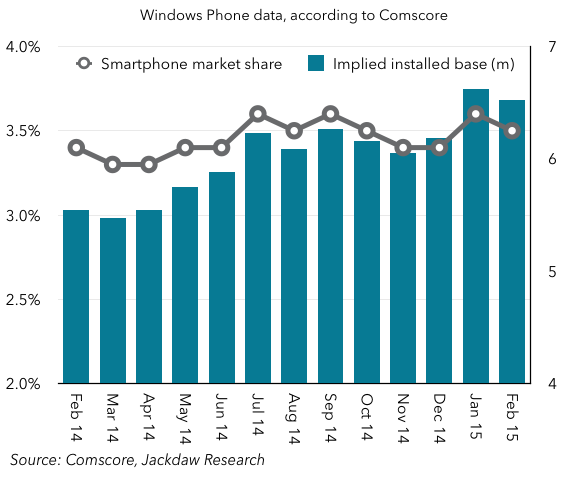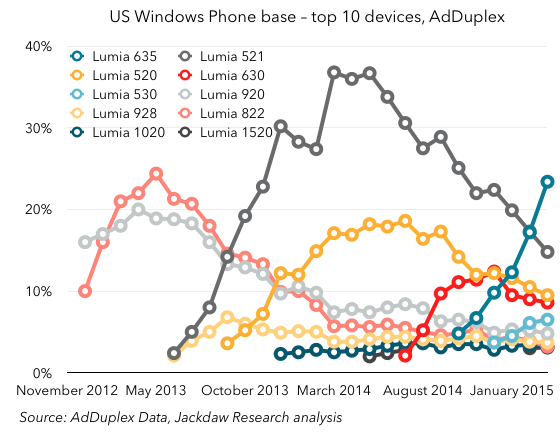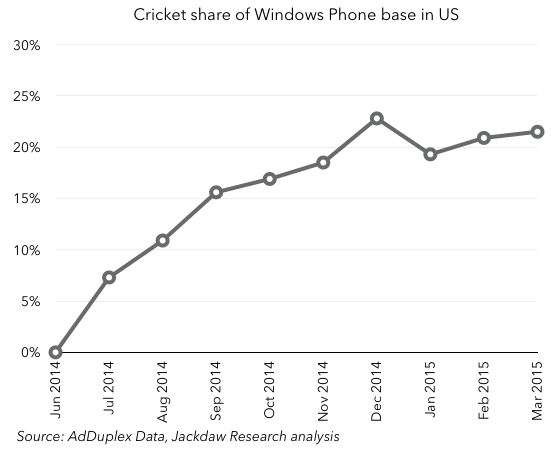Alternative title: Cricket is saving Windows Phone in the US
I’ve written quite a bit about Windows Phone previously, but I have a slightly different angle this time around — the impact prepaid is having on Windows Phone in the US and, in particular, the impact AT&T subsidiary Cricket is having on Windows Phone sales in the US.
I’m going to draw on a couple of different sources here:
- Comscore’s regular monthly updates on smartphone installed base market share in the US. I’m using these primarily to measure the size of the installed base for Windows Phone in the US. The latest data as I write is for February 2015.
- AdDuplex’s data on the Windows Phone installed base, based on its ad analytics software. Its latest numbers are for March 2015. I’ve used these numbers before for other purposes and Nokia in the past has occasionally pointed at them as well, which leads me to believe they’re generally pretty accurate.
Windows Phone in the US is growing
The headline from the recent Comscore data as it relates to Windows Phone is that the platform is growing, at least a little bit. The chart below shows the percentage market share number Comscore reports, as well as the installed base of devices this implies, based on Comscore’s overall smartphone market sizing:
What you can see is that market share is somewhat static, perhaps rising a tiny bit over time. But because the overall smartphone market is growing, the installed base this represents is also growing over time, from around 5.5 million a year ago to 6.6 million in January 2015 (the slight dip recorded in February likely isn’t meaningful). Given that Windows Phone is in a bit of a lull at the moment, since there hasn’t been a new flagship in quite some time (and isn’t likely to be another until Windows 10 launches later this year), where is this growth coming from?
As elsewhere, the low end is driving growth
The answer is pretty simple: as in other markets, from a device perspective, the growth is all coming from the low end. Here, we switch to the AdDuplex data on the Windows Phone installed base. AdDuplex only reports the top 10 devices in every market, so we don’t have a complete picture of the base, but we do know what’s selling best:
As you can see, what drove growth through the second half of 2013 and much of 2014 was the Lumia 521 and, to a lesser extent, the Lumia 520. Over the last six months or so, it’s the Lumia 635 that’s driving growth, with the Lumia 630 doing fairly well, too. The 500 and 600 ranges have been the lowest priced devices in the Lumia range, but they’re vastly outselling anything else right now both in the US and elsewhere.
The role of prepaid, and especially Cricket
So far, so predictable. But what’s particularly interesting in the US is the role of prepaid and especially the role of a single provider, Cricket. One of the nice things about the AdDuplex data set is the company breaks out wireless providers in the base, and one company that’s appeared to come out of nowhere over the last nine months is Cricket.
The history here is a little complicated, because today’s Cricket is actually the combination of two separate businesses: Leap Wireless, a CDMA-based prepaid operator which AT&T acquired, and Aio Wireless, a prepaid subsidiary which AT&T merged with Leap when the acquisition closed. Aio had a couple of Windows Phone devices before the transition, and the new Cricket launched its first Windows Phone handset, the Lumia 1320 phablet, in June 2014, followed in July by the Lumia 630, with the 530 and 635 landing later in the year. But, during that time, Cricket has gone from zero to over 20% of the base. The chart below shows that meteoric rise over a period of roughly nine months:
What gets really interesting is if you translate that share into a number in the installed base, based on the Comscore numbers. It’s a bit of a tricky calculation, because AdDuplex technically only breaks out Windows 8 devices by operator and there’s likely some number of Windows Phone 7 devices in the US base still, albeit a small one. But based on the combination of AdDuplex and Comscore data, it’s likely Cricket has between 1 and 1.5 million Windows Phone devices in its base, which is a fairly significant chunk of Cricket’s overall base, perhaps as much as 25%. Secondly, remember the overall Windows Phone growth numbers we looked at earlier? There was net growth of about 1 million Windows Phone handsets in the base during that same nine month period or, in other words, the difference between those that left the platform and joined it was 1 million. Given Cricket likely added around 1 million during that period, it’s possible it accounted for the vast majority of that net growth.
Windows Phone is disproportionately prepaid
Cricket isn’t the only prepaid brand where Windows Phone is big, though. It’s hard to get a full postpaid/prepaid breakdown from the AdDuplex numbers because, for the major carrier brands, the two aren’t separated. But even if we just focus on MetroPCS, Cricket and a phone only available on AT&T’s GoPhone prepaid service, these three add up to around 40% of the total base in the US. Add in a few percentage points for other prepaid sales on the major carriers and we could be getting close to half the Windows Phone base on prepaid, compared with about 25% of the total US phone base on prepaid. In this sense, Windows Phone is the anti-iPhone, with the iPhone well underrepresented in the prepaid market, just as Windows Phone is well over-represented.
The big question for me around Windows Phone remains whether this disproportionate emphasis on low end and prepaid phones will end at some point. The launch of Windows 10 in the coming months provides the best near term opportunity for Microsoft to re-engage with the premium end of the market, so these numbers will be well worth watching over the next year or so.



MS is getting some traction from “better the devil you know”. First-timers raised on desktop Windows somehow feel less threatened by Windows phones. And the Nokia/Lumia brand compares favorably to most other brands in that space.. If I set the bar at 100€, my go-to e-tailer offers Nokia, Huawei or Wiko… the risk-averse newbie choice is Nokia.
And there is a significant contingent of smartphone users, especially late adopters, who are not really using the “smart” part much. I’m still looking for data on actual app usage statistics(number and typology), but around me a good 25% of users could be on “touchscreen Symbian”. I’m curious to see if those evolve towards more app use later on.
I really like reading through a post that can make men and women think. Also, thank you for allowing me to comment!
Excellent article! We will be linking to this particularly great article on our website. Keep up the good writing.